We test a prototype Biigloo sleeping bag in subzero conditions, with very mixed results
When you purchase through links on our site, we may earn an affiliate commission.Here’s how it works.
(Image credit: Biigloo)
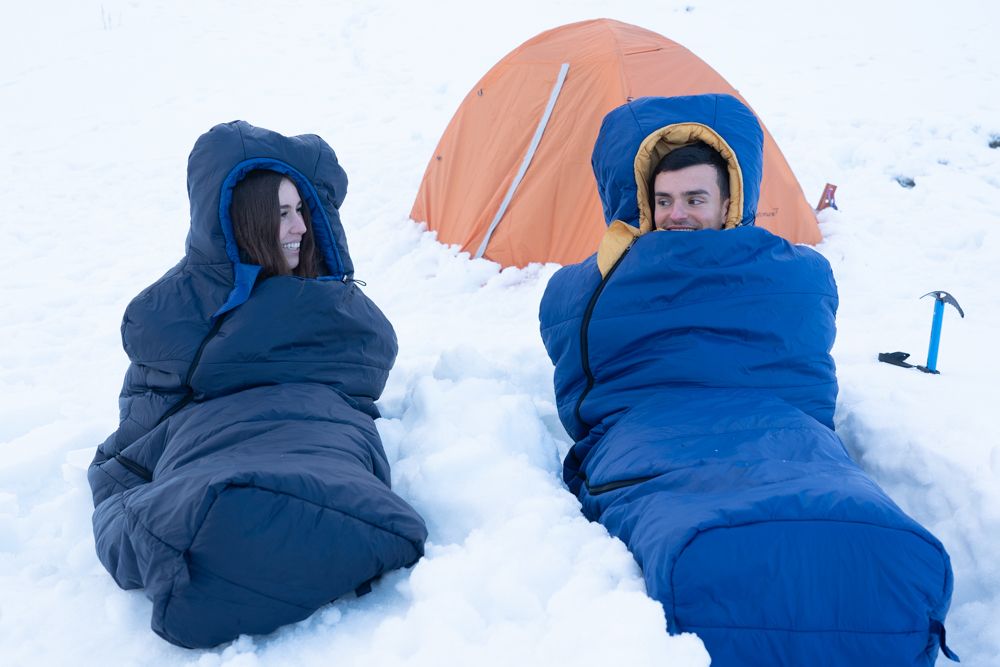
(Image credit: Biigloo)
The temperature in space is mad. Out in far-flung interstellar regions it can get down to a super shivery3 kelvins(-270.15°C), just a sliver above absolute zero (-273.15°C) which is thecoldest anything can get ever. Of course temperatures vary massively dependingwhere you arein relation to the sun, and whether you’re on a planet that has an atmosphere or not. But even on the surface of moon, where humans have left footprints, temperatures range wildly from +200°C to -200°C (+392°F to -328°F), which makes you wonder how lunar explorerssurvived at all, let alone felt comfortable enough to lark about and play golf.
As is often the case, materials developed for use in space work well on Earth too, and now Chinese brandBiiglooare making sleeping bags and quilts with a layer of aerogel within them. Biigloo say that 1mm of aerogel provides the equivalent amount of warmth to 40mm of down, and the material used in the construction of their sleeping bag isolates the user from freezing cold outside temperatures (as low as -40°C), while trapping generated body heat inside. They have launched akickstarter campaignto raise funds and publicity ahead of commercially rolling out these products, but are their claims even close to being true? Is this product destined to join the ranks of thebest sleeping bagsout there? We were sent a prototype of the bag to test. And trail test it we did, with some very mixed results.
(Image credit: Pat Kinsella)
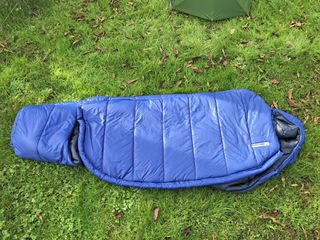
(Image credit: Pat Kinsella)
The Biigloo Sleeping Bag on test
For starters, -40°C (-40°F) is really freaking cold. These are the kind of temperatures you can expect to encounter in the deepest darkest reaches of Antarctic Siberia in mid January, so it’s tricky to truly test a product that claims to be able to operate in such extreme conditions (especially when you’re in Devon). It’s almost as hard to imagine that anyone who buys this sleeping bag will ever take it anywhere close to -40°C. Nevertheless, if you’re going to imply a product can protect people in life-threatening environments like this, you really should be 100% certain that it can, otherwise someone might die.
And ‘imply’ is the important word here. Because while the marketing material around the Biigloo sleeping bag talks about how aerogels can operate in -40°C, the actual product has an in-built temperature gauge (an interesting feature in itself), which indicates the comfort range of the sleeping bag is between 16° and 28°. It doesn’t specify whether that’s Celsius or Fahrenheit, but presuming it’s the latter then that means the comfort rating of the sleeping bag is -9°C to -2°C.
The Biigloo sleeping bag temperature gauge is a good feature(Image credit: Pat Kinsella)
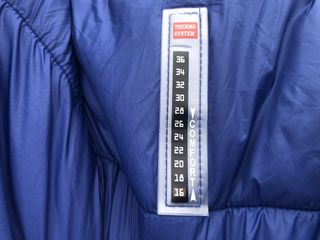
The Biigloo sleeping bag temperature gauge is a good feature
The Biigloo sleeping bag temperature gauge is a good feature
(Image credit: Pat Kinsella)
The Biigloo Sleeping Bag: thermal performance
While I couldn’t afford a trip to Siberia, I did test the Biigloo sleeping bag during January in Devon, while camping in conditions that saw overnight temperatures get to -3°C (26.6°F). For this test I was using the bag in conjunction with theAlpkit Whisper insulated camping mat(which has an R-rating of 2.5) and theAlpkit Soloist tent, both of which are really designed for 3-season use.
So, was I warm? The Biigloo sleeping bag has a smooth texture on the inside as well as the outside, and I found it very chilly to the touch when I first climbed into it. I soon warmed up, though. However, during the small hours of the morning, when temperatures were at their lowest, I did experience the odd shiver, and after getting up to look at the stars and have a pee, I put on a thermal top. Unfortunately, while getting back into the bag the zip broke. And I couldn’t fix it.
Sign up to the T3 newsletter for smarter living straight to your inbox
Get all the latest news, reviews, deals and buying guides on gorgeous tech, home and active products from the T3 experts
Sadly, the zip on the prototype test model broke on the first use, but Biigloo have said this flaw will be fixed before the bag goes on the market.(Image credit: Pat Kinsella)
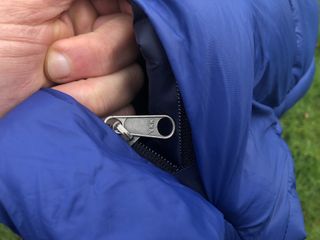
Sadly, the zip on the prototype test model broke on the first use, but Biigloo have said this flaw will be fixed before the bag goes on the market.
Sadly, the zip on the prototype test model broke on the first use, but Biigloo have said this flaw will be fixed before the bag goes on the market.
(Image credit: Pat Kinsella)
Now, I should stress I was testing a prototype of the bag, and I expect the build quality of the final product to be a lot more robust (it simply needs a stopper added to the end of the zip run), but this malfunction meant I had to spend the rest of the night using the sleeping bag as a duvet. And I wasn’t warm enough to get a comfortable night’s sleep with this set up.
If I was being more generous than I felt at 5am that morning, I would give this bag a lower comfort rating of somewhere between -5°C (23°F) and -3°C (26.6°F) when the zip is working, at the absolute most (and I’d recommend wearing thermalbase layersas pyjamas and using avery good sleeping matwith it when temps are at the southern end of that scale). This is a long way from the -9°C rating the integrated temperature gauge implies, and several Arctic miles from the -40°C limit that the promotional campaign references. The following night I slept in my back-up sleeping bag, theAlpkit Pipedream 400, which is considered a 3-season bag as has a comfort rating of -4.2°C, and I was almost as warm.
Biigloo sleeping bag specifications
The Biigloo sleeping bag (packed into an unrelated drybag) next to theAlpkit Pipedream 400(Image credit: Pat Kinsella)
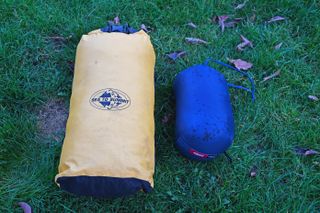
The Biigloo sleeping bag (packed into an unrelated drybag) next to theAlpkit Pipedream 400
The Biigloo sleeping bag (packed into an unrelated drybag) next to theAlpkit Pipedream 400
(Image credit: Pat Kinsella)
The Biigloo Sleeping Bag: weight and bulk
Again, I was testing a prototype of the sleeping bag, and it did not come with a stuff bag or a compression sack (something the company have assured me will be included when the product goes on the market). But this is a big, bulky sleeping bag, and while aerogels might boast an extraordinary warmth-to-weight ratio (the product weight is 50g per square metre), this is only one, relatively small, part of the ingredients that has gone into this sleeping bag. I really struggled to stuff it into a 20Ldry bagin order to take it out on the trail, and it took up a large amount of space in myhiking backpack.
The Biigloo sleeping bag - splash test(Image credit: Pat Kinsella)
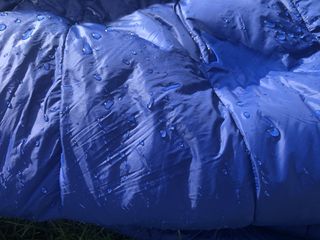
The Biigloo sleeping bag - splash test
The Biigloo sleeping bag - splash test
(Image credit: Pat Kinsella)
The Biigloo Sleeping Bag: materials
In addition to the thin layer of aerogel, the sleeping is filled with DuPont SORONA bio-fleece, which is partly derived from plant fibre (unspecified percentage). The outer of the sleeping bag is made with 20D400T ultra-fine nylon, which is breathable, windproof and has high abrasion and tear resistance. Biigloo claim the bag offers a high water-resistance level (up to 10,000mm).
Here the bag performed better. I can’t verify whether it really has a hydrostatic head rating of 10k (which is a big claim), but I did chuck liberal amounts of water on the sleeping bag and it pooled and beaded on the outer material, before running straight off without penetrating the fabric. The inside of the sleeping bag remained dry, and I think I would be confident using this bag for hammock camping and bivvying where moisture and light rain might be encountered. It would probably work well in snow too (as pictured in the promo material), while snow-holing for example, although I didn’t get a chance to test this firsthand this winter.
Kryptonite? No, this is aerogel - the enemy of cold and potentially a wonder substance for outdoor kit(Image credit: Biigloo)
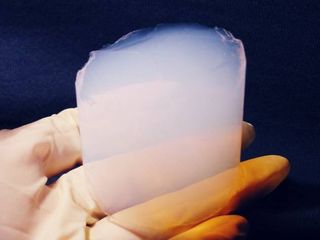
Kryptonite? No, this is aerogel - the enemy of cold and potentially a wonder substance for outdoor kit
Kryptonite? No, this is aerogel - the enemy of cold and potentially a wonder substance for outdoor kit
(Image credit: Biigloo)
Aerogel is non also a fibrous material, so it doesn’t breed bacteria, accumulate bad odours and is and easier to clean. If you do feel the need to launder the bag, it can, apparently, be washed 100 times without losing any of its thermal properties.
(Image credit: Pat Kinsella)
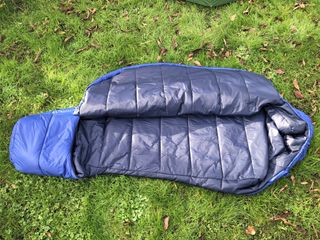
(Image credit: Pat Kinsella)
The Biigloo Sleeping Bag: Design
The Biigloo sleeping bag is mummy shaped, and at 210cm long is quite generous in its sizing. It has a double-ended YKK zip (which will hopefully be better finished in the final product, as per above), which instead of simply running the length of the bag on the left or right side, opens and shuts via an unusual wrap-around L-shape design. I quite liked this, and it does make the bag easier to get in and out of, and makes it comfortable to use (especially if you sleep on your back), but it also means you can’t ventilate your feet if you over heat.
The Biigloo sleeping bag has decent hoods, which can be pulled in tight around your face to keep drafts out and warmth in. Finally, the bag features ‘horizontal diffraction seams’, which effectively prevents the padding from moving around and avoids cold spots developing.
(Image credit: Pat Kinsella)
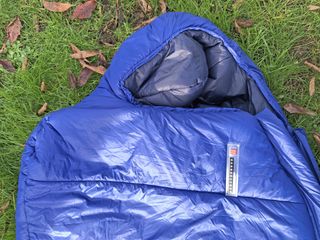
(Image credit: Pat Kinsella)
The Biigloo Sleeping Bag: conclusion
Despite all the marketing hype, this bag has precious little to do with NASA, and it will not keep you warm down to -40°C as implied, so I don’t advise taking it on mid-winter camping trips to Siberia. But, it is a genuinely warm (to around -5°C) and weatherproof sleeping bag, which will do a decent job in the vast majority of conditions you’re ever likely to face while camping out during adventures in Britain.
The use of aerogels in a sleeping bag is a really interesting innovation, and it seems to supply real protection against the cold, damp and wind, which is all highly applaudable, and makes this a bag I would use in lots of scenarios where you are more exposed to the elements, from bivvying and hammock camping to snow holing.
I also like the use of a more eco-friendly bio-based filling material along with the aerogel layer, but it is a bulky bag at the moment (although not outrageously so, and in some of the scenarios mentioned above, it would be well worth paying the weight and bulk penalty in order to benefit from the weather protection it offers).

Samsung Galaxy S25: every leak, rumour and spec we’ve heard before the launch eventThis is everything we’ve heard about the new handsets
This is everything we’ve heard about the new handsets

This case turns your iPhone or Android phone into an e-reader, but there’s a catchActually, there are a couple…
Actually, there are a couple…
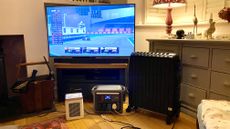
Change my mind: the smaller, the better with portable power stationsPut your portable power station to work when you’re not using it
Put your portable power station to work when you’re not using it
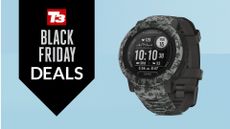
This rugged adventure Garmin is mega cheap in Walmart’s Black Friday saleThe Instinct 2 is a top watch for outdoor and sport enthusiasts
The Instinct 2 is a top watch for outdoor and sport enthusiasts
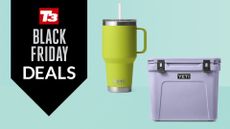
YETI’s best-selling products are ridiculously cheap in Amazon’s Black Friday saleFancy yourself a tumbler, rambler or cooler? Amazon’s reduced them all
Fancy yourself a tumbler, rambler or cooler? Amazon’s reduced them all

MSR Hubba Hubba Bikepack 2 review: Lightweight, storm-proof shelter with room to stretchA superb tent, tweaked to make it perfect for pedal-powered adventurers
A superb tent, tweaked to make it perfect for pedal-powered adventurers
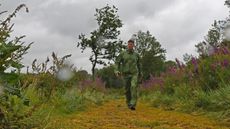
Columbia Wyldwood Waterproof Hiking Shell review: the most waterproof (and shiny) jacket I’ve ever wornIt might not have the matt finish most people expect from a jacket, but the Wyldwood really shines when it comes to protecting you from wet and windy weather
It might not have the matt finish most people expect from a jacket, but the Wyldwood really shines when it comes to protecting you from wet and windy weather
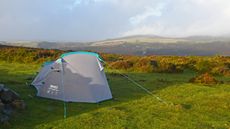
Olpro Stafford 2.0 review: 2-person backpacking tent made from plastic bottlesGood for backpacking couples, this mid-range, 3-season shelter is constructed from recycled trash
Good for backpacking couples, this mid-range, 3-season shelter is constructed from recycled trash
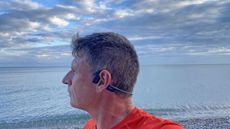
Shokz OpenRun Pro 2 review: Smart bone conduction headphones with enhanced bassShokz’s headphones changed my opinion about running while listening to music, and now I struggle to go out without them
Shokz’s headphones changed my opinion about running while listening to music, and now I struggle to go out without them

Outdoor chef shares 5 fall camping meals to keep you full and energisedWarm yourself up from the inside out with these hearty autumn recipes
Warm yourself up from the inside out with these hearty autumn recipes